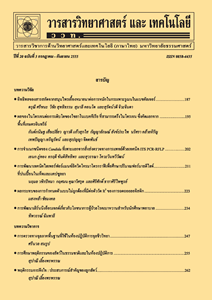เห็ดยอเพื่อสุขภาพจากเห็ดมิลค์กี้
Main Article Content
Abstract
This research aimed to optimize the formula to produce hed-yor from milky mushrooms. The eleven formulations of hed-yor consisting of milky mushroom (30-70 %), wheat flour (20-50 %) and water (0-20 %) were studied by using mixture designs. Physical properties and sensory test were investigated. Obviously, the mixture response surface contour plots showed that the percentages of weight loss during steam of hed-yor were directly affected by the milky mushrooms and water contents. Moreover, its hardness was increased by expanding wheat flour content. Interestingly, a suitable formulation of hed-yor was 56 % milky mushrooms, 34 % wheat flour and 10 % water. This formulation had the highest score of appearance (7.57±0.63), flavor (7.17±0.91), taste (7.20±0.85), texture (7.63±0.72) and overall liking (7.63±0.96). Furthermore, formulations with glutinous rice flour, rice flour and cassava flour to replace wheat flour (control formula) in hed-yor production were studied. The results showed that formula with rice flour had the highest average overall liking score, and it was not different from that of the control formula. In conclusion, hed-yor product has been suggested to be an alternative for consumers who want to avoid meat and gluten-containing foods.
Article Details
References
[2] Duamkhanmanee, R., King Bolete Mushroom Village Project under the Village Network of Science and Technology, Available source: https://www.rdi.rmutsb.ac.th/2011/clinic/download/report/03/8.pdf, May 5, 2018. (in Thai)
[3] Subbiah, A.K. and Balan, V., 2015, A comprehensive review of tropical milky white mushroom (Calocybe indica P & C), Mycobiology 43: 184-194.
[4] Thai Industrial Standards Institute, Thai Community Product Standard (Prok sausages, Mu Yor) 102/255, Available source: https://tcps.tisi.go.th, May 5, 2018. (in Thai)
[5] Laurujisawat, P., Healthy Food, Available source: file:///C:/Users/MAG/Downloads/HealthyFood%20(4).pdf, May 5, 2018. (in Thai)
[6] Marino, M., Casale, R., Borghini, R., Nardi, S. D., Donato, G., Angeloni, A., Moscaritolo, S., Grasso, L., Mazzarella, G., Tola, M. D., Rossi, M. and Picarelli, A., 2017, The effects of modified versus unmodified wheat gluten administration in patients with celiac disease, Int. Immunopharm. 47: 1-8.
[7] Duncan, D.B., 1995, Multiple range and multiple F tests, Biometrics.11: 1-42.
[8] Rattanapanone, N., 2006, Food Chemistry, Odeon Store, Bangkok, 504 p. (in Thai)
[9] Srirod, K and Piyajomkhawn K., 2003, Flour technology, Kasetsart University, Bangkok, 303 p. (in Thai)
[10] Peeraphatchara, C., Panyathitipong, W., Manarote, A. and Hiran-Akkarawong, I., 2016, Development of food products from banana for vegetarian food business, Research Report, Rajamangala University of Technology Phra Nakhon, Bangkok. (in Thai)
[11] Yuenyongputtakal, W., Limroongreungrat, K., Chaipan, P. and Srimuang, T., 2017, Effect of hot air drying temperature and time on qualities of enoki mushroom (Flammulina velutipes) powder produced from uncommonly consumed part, T. Sci. Technol. J. 25: 1001-1014. (in Thai)
[12] Fitterman, L. 2018, Inside the Race for a Celiac Disease Treatment, Available Source: https://www.allergicliving.com, May 8, 2018.


